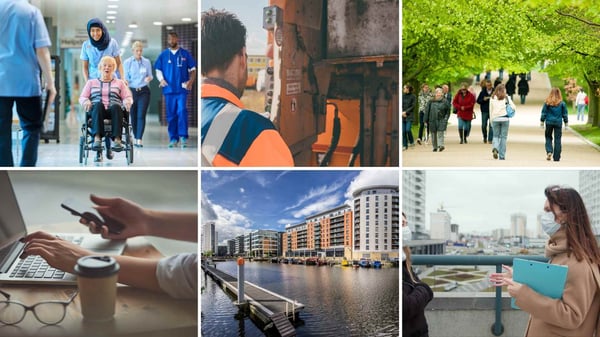Delivering a seamless citizen service experience in local government
What steps should local government be taking to deliver a seamless citizen experience for residents? Four local administration executives joined Government Transformation's David Wilde to share their advice on measuring customer demand and how local authorities can continue building on the “delivery under fire” achieved during the pandemic.
What is a seamless citizen service experience?
Delivering a seamless, end-to-end, citizen-centric experience is a top priority within local government, but what do people mean by ‘seamless citizen service experience’?
For Isabel Edgar, Assistant Director for Corporate Improvement and Customer Service at Reading Borough Council, it is about removing the complexity behind service delivery and assuming that the resident “needs to know nothing about the local authority”.
“The customer doesn’t need to know anything about local government to be able to interact with us,” said Edgar. “This mindset approach means that we don’t have to provide instructions for our customers, they don’t need to understand the machinations of local government because it’s a really complex landscape, very legal, and I think all of that is noise.”
Eliminating complexity and "friction" is also key to a seamless citizen service experience for Jenny Payne, Head of Customer Experience and Improvement at Cornwall Council. To achieve this, her team has started looking at processes, systems, procedures and accountability from an “outside in” view.
“We have traditionally designed all our processes from the inside out and we need to start looking from the customer's end,” Payne said at the Citizen Experience Show. “Service users shouldn't have to understand the complexity that may be going on in the background to deliver what they need. We need to make it simple, smart. But it does take a mindset change.”
Essential to unlocking seamless services is understanding the citizen experience, where the pain points are and what the relationship is between local authorities and residents. But for Nic Streatfeild, Managing Director at public sector experience management provider GovMetric, ‘seamless’ means different things to different service users, and that should be taken into account in the design and delivery of local public services.
"Seamless means a different thing to different customers accessing different services."

“If you look at the whole spectrum of local services, at one end you’ve got complex personal services that are a completely different kettle of fish to the ones you find at the other end of the spectrum, where we might have simple repetitive property-related services,” Streatfeild said.
“Seamless means a different thing to different customers of different systems accessing those different services.”
Measuring service demand
Despite continuing funding challenges, demand for local services continues to grow, threatening delivery success. Measuring this demand quantitatively and qualitatively helps local authorities better allocate resources.
Prior to joining the London Borough of Camden as Head of Customer and Registration Services in March, Phil Quickenden was Head of Contact and Assessment at Suffolk County Council, where he saw an increase in demand complexity rather than volume, including complex social care and financial hardship cases.
“People are presenting much later in their journey with their challenge creating more significant needs,” Quickenden said. “We’re in the middle of a cost of living crisis and that translates into longer calls and a broader set of skills required by agents. How do we upskill our staff to have a much more values-based conversation, much less transactional, to try to get to the root cause of somebody's problem?”
Tracking that demand, he added, needs a qualitative use of data that makes use of soft intelligence. For example, although the amount of calls received by councils might not have changed substantially, assessing how long those conversations last and where those customers move on to in their journey can help measure services more effectively.
Data interoperability and breaking down silos, as happened during the pandemic, brings more valuable insights into service delivery and offers a holistic understanding to start drilling into problem areas, added Streatfeild.
Changing customer profiles
The cost of living crisis is forcing many people to engage for the first time with their local authorities as they're responsible for delivering a range of welfare services and benefits, including housing, disability benefits and employment support.
Although some citizens are familiar with the system already, this new type of customer might be “bewildered” by it, said Edgar. Her authority is collaborating voluntary and community sector (VCS) to signpost these new customers to help them navigate the system and find a solution to their needs.
“We are working closely with the VCS to build on that great work that we did during Covid,” Edgar continued. “We're supporting the VCS through grants and funding and partnership working as we can't just keep absorbing that demand.”
Although local councils had been encouraging residents to use online services for years, it was not until the pandemic began that a significant channel shift finally happened.
“We have been desperately trying to encourage people to move online and Covid helped us do that,” said Cornwall Council’s Jenny Payne. This led to a significant investment in digital services as councils seeks to encourage users to access their services online rather than returning to council offices.
Like Edgar, Payne’s team is also working with partner organisations to help them support the increase in demand from new demographic groups while the council lacks the resources to have individual phone calls with each of them.
“We're often the first port of call for a lot of people because they don't know where else to go - they’ve never been in this situation of needing help,” Payne continued. “I'd love to find a way that we stop them coming in the first place - how can we signpost them to the right place to go for the first time?”
Quickenden concluded by saying that local authorities should continue building on the channel shift and “delivery under fire” achieved during Covid: “Let's turn that into that seamless customer journey that we want, rather than just a quick fire fix that gets us through an emergency.”
The full 'Delivering a Seamless Citizen Service Experience in Local Government' panel discussion, sponsored by GovMetric, is available to watch on demand here. 





